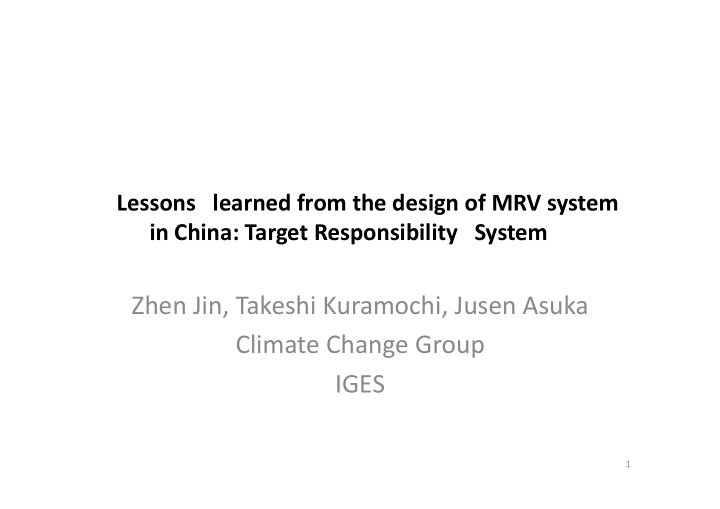



Lessons learned from the design of MRV system in China: Target Responsibility System Zhen Jin, Takeshi Kuramochi, Jusen Asuka Climate Change Group IGES 1
1. Awareness of Chinese government on Climate Change impact Certainly and serious damage with the natural environment Temperature Change: Since 1901, the annual mean surface air temperature increased by 0.98 ° C; a • warming rate of 0.25 ° C/ decade in the last 6 decades. • Precipitation Change: after 1990s, the precipitation in springs and autumns decreased significantly (3.2 mm/decade and 3.6 mm/decade respectively), decreased in the western, and increased in the Northeast. • Changes of Extreme Climate Events: In the last 60 years, the extreme warm events have increased and the extreme cold events have decreased; increasing of both droughts and Floods. • Agriculture: after 1950s, the area affected by droughts increased fourfold to 14.5 million ha in 2000-2008. • Sea Level: In the last 30 years, the coastal sea level has rising with rate of 2.6 mm/year, higher than the global rate (1.7 mm/year). Figure 1. Changes of annual mean surface temperature in mainland China in the past 100 years. source: Second National Communication on Climate Change of The People’s Republic of China 2
2 . Stance of Chinese government on Climate Change policies Climate Change policies = Benefits of Overcoming the Air Pollution High dependency on coal production in china (77.6% of Energy-saving policies the total primary energy production in 2010); coal burning is a major source of SO2 and particulates which reduce the CO2 intensity by are the contributor to acid rain, photochemical smog. 17%; cut the energy intensity by In 2011, More than 90% of the SO2 emissions form the 16% over the period 2011 to industrial sector (power plant, steel, etc.), and 51.7% of that from the power sector. 2015. In 2011, 12.9% of the total land area damaged by acid Increase the proportion of non- rain. Out of 468 monitored cities and towns, 227 was suffered damage. fossil fuels in energy In 2011, 82% of key air pollution control zones (including consumption to 11.4 per cent 19 rejoins such as BeiJing, TianJin, ShangHai,etc.,which by 2015. covers 14% of the total land area and hosts 48% of national population ) did not meet the National Air standard. Benefits of Promoting the industrial competitiveness To facilitate optimization of industrial structure, phase out the backward production capacity, and restran excessive production capacity and redundant construction Development of the renewable energy and environmental industry. 3
3 . Polices Taken in the 11th FYP Period and its results Cut the energy intensity by 20% ⇒19.1% • Non-fossil fuel, renewable energy • (almost accomplished), reduced 1.49billion CO 2 11次5カ年計画期間における部門別目標、達成状況 (2005年比、2010年まで) 11次5カ年計画期間における非化石エネルギー目標 単位:10,000Kw 部門 省エネ目標 達成状況 11次5カ年目標 達成状況 2010年、鉄鋼、セメントなど13の製品のエ 水力発電 19000 21000 ✓ 原単位規制 ネルギー原単レベルを今世紀初頭の国 基本達成 ✓ 際先進レベルに到達 原子力発電 1252 1082 × 千社企業プログラムによる1億tce省エネ 1.5億tce ✓ 風力発電 1000 4473 ✓ 目標 工業 太陽光発電 30 90 ✓ 10の省エネ重点プロジェクトによる2.4tce プロジェクト 3.4億tce ✓ 省エネ目標 バイオマス発電 550 500 × 非効率生産設備の淘汰 1.1億tce ✓ 省エネ1.01億tce、省エネ建築面積21.5億 建築 省エネ建築 40.8億㎡(2009年まで) ✓ ㎡ Carbon stock, forestation • 陸運サービス車輛の百トン・kmあたりエ 道路 データなし △ ネルギー原単位の‐10% 水運サービス船舶の百トン・kmあたりエ 水運 データなし △ 11次5カ年計画期間における非化石エネルギー目標 ネルギー原単位‐20% 交通 営業収益あたりのエネルギー原単位‐ 目標 達成状況 (2009年までのデータ) 鉄道 -23.80% ✓ 20% 植林 400万ha データなし △ 航空 トン・kmあたりエネルギー原単位の‐10% ‐11.3% ✓ 森林被覆率 20% 20.4% ✓ 太陽光、バイオマス、風力、小型水力等 森林蓄積量 132億m 3 133.6億m 3 ✓ 農業 エネルギー に発電支援事業による5000万tce省エネ データなし △ 能力の開発 第三産業 サービス産 サービス産業を40.3%から43.3%まで引き 43.10% × 業 あげる(3%目標) Source : 2012Blue Book of Low ‐ Carbon Development 4
4 . Energy ‐ Saving target responsibility system(TRS) 図 2 : Scheme of TRS Scheme of TRS State council sets National targets (energy intensity target, Controlling Total Energy Consumption to 4 billion tce by 2015), and distributed to local governments as mandatory targets; Target achievement status is linked to personnel evaluation, with possible punishment measures. The allocated target distributes to the enterprises in the cooperation of a country and the local government 4. Source: MRV Report ) 5
5 . Scheme of MRV, challenges 図 3 : Scheme of MRV challenges Lacking accuracy of coal statistics (double counting); lacking reliability of self-assessment data from enterprises, Statistical standards for Enterprises with the annual turnover Less than 20 million in each region are ② different. Increasing the efficiency of statistical system; Securing of human resources ③ Strengthening supervision and audit for local governments and enterprises 6 Source: from IGES research output
Recommend
More recommend